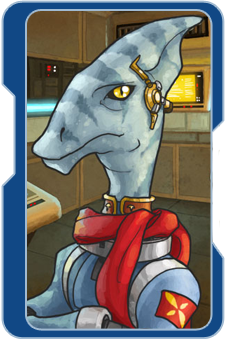Developerís Diary: 10/17/2014
Adam Solo of SpaceSector.com just sent me a list of questions on the gameís design. Many of them big, personal topics like ďwhat games have inspired youĒ and ďwhat separates Stars in Shadow from other titles in the genre?Ē. These are good questions, and Iím including my answers to some of them in this post. But an even better question, I think, is the one Iím going to take a shot at answering right now, namely:
What are your goals as a game designer?
At the highest level, the goal is to make a game I enjoy playing. And so of course the games Iíve most enjoyed in the past, of whatever genre, have all had smaller or larger impacts on the design. As a gamer, the title Iíve most recently lost myself in is XCOM; before that my main obsession was Sword of the Stars, though I also found time for a healthy mix of Bioware RPGs and Anno 2070. Master of Orion 2 is high on my list of all time classics, as are Homeworld and Star Control 2.
4X games, like MOO2 or SOTS, have always held a particular fascination for me. Iíve yet to play one that doesnít feel, in one sense or another, badly flawed. I love them in spite of that -- but I think I see in the genre the potential for a game thatís very similar to MOO on the surface, but which removes a lot of the rough edges.
This is a big, sprawling topic. But if we really boil it down, there are three essential goals. I want Stars in Shadow to be a 4X game that 1) can be played from start to finish in a single evening 2) emphasizes turn based tactical battles and 3) is set in a world worth losing myself in.
A big part of the draw of a game like MOO is that youíre leading an entire species though this epic sweep of history -- starting with their first interstellar explorations and ending, centuries later, with a galaxy-spanning empire. Itís a premise I find very compelling. But the 4X design has a way of collapsing under the weight of itís own ambition. Weíre trying to merge a sophisticated turn based strategy game, something comparable to Civilization, with a highly involved tactical game. Thatís a lot of different moving parts -- and thereís a lot that can go wrong when they come together.
As a game designer, you need to decide which gameplay elements youíre going to focus on; and which youíre willing to deemphasize. The intended focus, in Stars in Shadow, is turn-based tactical combat. Thatís a significant point of divergence from many of the other titles in the genre. Endless Space, for example, is a case where the designers made exactly the opposite choice -- focusing on strategy while trimming the tactical game down to itís most basic form.
In Stars in Shadow, the trimming and streamlining happen in the strategic game. Managing your colonies is not intended to be as deep or consuming an experience as Civilization's city building. In many situations, simply leaving your colonies to their own devices for a couple turns while you prepare for your next fleet battle should be the best action a player can take
The emphasis on tactics over strategy is a big part of how Iím hoping keep game times in check. Heroes of Might and Magic maps tend to play much more quickly than Civilization scenarios; and I suspect thereís a fundamental reason for that. When city management is the core of gameplay, each new city added to your empire tends to increase the time it will take to finish a turn. As a game designer, there are some things you can do to mitigate that escalating complexity. You can add mechanics like Civ 5ís happiness value, forcing players to pick and choose a small set of cities that theyíll actively control. Or you can find a way to limit the amount of micromanagement thatís allowed during a given turn, a Koei does in Romance of The Three Kingdoms. But fundamentally, youíre fighting against the natural consequence of a game design that emphasizes city management. When the focus of the game is tactical battles, however, thereís no longer a necessary link between how powerful a player is, and how many different things they need to keep track of. In a tactics-focused game, expanding over the map at a steady pace becomes far more natural.
All that said, the most important design goal, in my mind, is the last one. I want the game world to be immersive; I want to the stories players create for themselves to have real weight to them. Asking what it takes to make a game world immersive is like asking what it takes to write a good book -- thereís no one formula for success; what ends up mattering is how well a collection of little details fuse together into a single whole.
And in this Iím very fortunate to have Jim Francis working on the project. The ship art that Jim has done is extraordinary -- you get a strong sense of each raceís character from the designs; and with tactical battles at the core of gameplay, itís the ships that set the tone for the rest of the game. The planets are another piece Iím quite proud of -- both of us find ourselves occasionally pulling up a planet screen, staring at the spinning world and daydreaming about the lives our alien subjects are living. I think thatís a very good sign. Refined gameplay is all well and good -- but I play 4X games primarily because I want to immerse myself in a sci-fi world -- and that means quality art is as important as good mechanics.
Among other things, Jim is a gifted storyteller. I think thatís part of what I most enjoy about his art -- Jim says he canít draw a spaceship without thinking through how it works and why it was built, and drawing a planet is apparently impossible without inventing a history for it. Stars in Shadow has become a setting I look forward to spending time with -- and thatís largely due to the wonderful work Jim has done in bringing it to life.
The game reminds me of Master of Orion in many ways, especially the tactical combat. Was it your main source of inspiration? Others?
My goal as a designer is essentially to do with MOO2 what Valve did with Quake. To take a set of classic mechanics and refine and elaborate on them to the point that the gameplay experience becomes something quite different. I'm not the only designer with such high aspirations, of course. We're in the midst of a real renaissance of 4X titles; and most of us are trying, in one way or another, to "remake MOO".
I think Sword of the Stars needs to be given a lot of credit for this burst of new titles. I'd daydreamed about making a MOO-like game since childhood, but when SOTS launched on Steam, Kerberos proved not only that there was still a place for 4X games in the modern era, but also that there were significant ways we could really improve on the old classics.
One of the big things I always regretted about MOO2 was that so many of the most interesting technologies were stuck up at the top of the tech tree. Inevitably, by the time you got to use star gates or cloaking devices, the game was essentially over. Give a carefully chosen selection of game changing techs to specific races in the early game, however, and you can make the distinctions between the different factions a lot more interesting. A hugely successful example of this in SOTS is the Hiver's design. Give the Klackons stargates at the start of the game, and you get some really extraordinary implications, both in terms of world building and gameplay.
Stars in Shadow, like SOTS, has one big master tech tree, though only parts of it are accessible when you start a new game. Which parts depend first and foremost on the race you choose; but game events, like colonizing an artifact world or defeating a pirate faction, may unlock additional branches. Diplomacy can also broaden what's possible, as in some situations, other empires will be able to trade you techs that you wouldn't be capable of researching yourself. And while Iím not quite shameless enough to steal the Hiverís design directly -- there is one faction that starts with stargates, and another with early cloaking devices.

